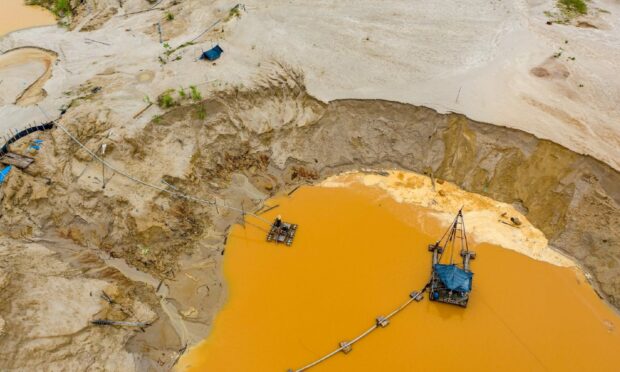Environmentally-friendly waste specialist Sem Energy is putting its innovative filtration technology to good use in trying to deliver more sustainable mining in the Amazon.
Aberdeen-based Sem has taken its aptly-named “Dram” product to Madre de Dios, Peru, to help a local gold miner clean up waste produced through the extraction process.
The Dram system uses by-products from whisky distillation. These act as a filter to separate different types of waste metal by using chemistry and various biological processes, including ion exchange.
Whisky is obviously less easy to come by in Peru, but there is a growing craft beer scene and we are looking to collaborate with some of the nearby breweries to help fuel the Dram tanks.”
Leigh Cassidy, lead scientist, SEM Energy.
Sem’s technology will be used to treat contaminated water, which often contains potentially toxic chemicals and waste metals, to a point where it can be safely released into a river.
The valuable metals can then reused and resold – in this case offering an additional revenue stream for miners.
Sem’s Peruvian mission is part of a global innovation competition, the Artisanal Mining Grand Challenge.
Backed by the US Agency for International Development and Microsoft, among others. the initiative is aimed at tackling the social and environmental cost of artisanal and small-scale mining in the Amazon region.
It is fantastic to see technology developed in Scotland having a positive impact on communities and ecosystems on the other side of the world.”
Liz Fletcher, business engagement director, Industrial Biotechnology Innovation Centre.
Just 13 projects were chosen from more than 120 international applications for the challenge
Sem – founded in 2016 by chief executive John Jones and chief operating officer Grant Leslie – developed its groundbreaking filtration technology in partnership with Edinburgh University and the Glasgow-based Industrial Biotechnology Innovation Centre (IBioIC).
Balancing livelihoods and the environmental challenge
Leigh Cassidy, lead scientist at the company, said: “Witnessing first-hand the impact of small-scale mining and the lack of regulation protecting communities in South America really highlights the need for a more sustainable approach to the traditional mining process.
“While, of course, it is many people’s livelihoods, at the moment it is causing a real environmental challenge, with rainforest being cleared to make way for new mines and polluted water released into the Amazon.
“There is also a challenge around infrastructure, and it is hard to put into perspective just how remote and inaccessible some of these jungle mines are.
“Whisky is obviously less easy to come by in Peru, but there is a growing craft beer scene and we are looking to collaborate with some of the nearby breweries to help fuel the Dram tanks, as well as experimenting with the peelings of locally grown cassava.”
Legacy ambition
Ms Cassidy added: “Importantly, the system operates without the need for electrical power.
“The ultimate aim of the challenge is to not only implement more environmentally friendly practices but to leave a legacy behind where local miners can continue to use the technology themselves for years to come.
“In doing so, we’re laying the foundations for a significantly more sustainable approach to mining.”
SPIN OUT SUPPORT
Up to £20k towards HEI costs for spin-out projects using innovative biotechnology solutions & addressing a real market need/ commercial opportunity.
Applications assessed on a rolling basis.
👉https://t.co/ams22mL5M8#Spinout #funding #innovative #biotechnology— IBioIC (@IBioIC) September 7, 2022
IBioOC business engagement director Liz Fletcher said: “It is fantastic to see technology developed in Scotland having a positive impact on communities and ecosystems on the other side of the world.
“Our work with Sem last year proved the case for the bio-based Dram system, which could now play an important role in protecting the Amazon and transforming mining practices.
“The grand challenge shows the power of collaboration and knowledge sharing between local industries, academics and technology experts, and we are excited to hear more about the results.”
Small-scale operations account for around one-fifth of newly mined gold production in the Amazon and is an important industry for many rural communities.
But it is also associated with hazardous working conditions and environmental concerns.
While the Madre de Dios site is primarily a gold mine, additional metals extracted include silver, copper, lead and mercury, which can be particularly problematic for aquatic life and even humans if it enters the food chain via water.


Conversation